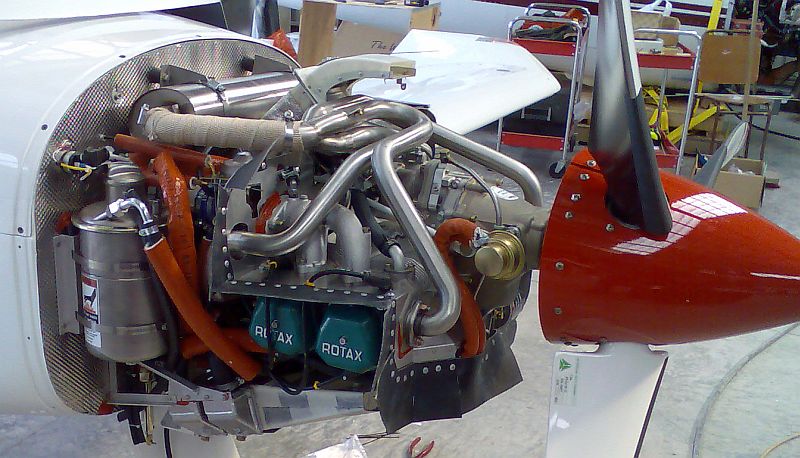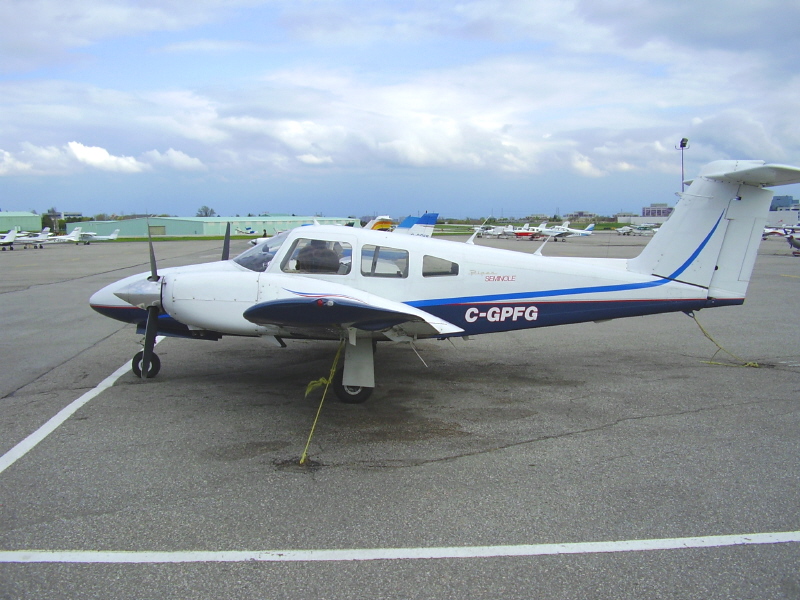|
Maule M-5 Lunar Rocket
The Maule M-5 is an American four-seat cabin monoplane designed and built by the Maule Aircraft Company. Design and development The M-5 was a development of the earlier Maule M-4 with improved STOL performance. It has a 30% increase in flap area and enlarged tail surfaces. Two prototype M-5s flew in 1971, one powered by a 210-hp (157 kW) engine, the other with a 220-hp (164 kW) engine. The M-5 is a steel-tube and fabric high-wing braced-monoplane with a cantilever tailplane with a single fin and rudder. It has a fixed-tailwheel landing gear and an enclosed cabin with two rows of side-by-side seating for a pilot and three passengers. The aircraft entered production in 1974 and was named the Strata Rocket and the Lunar Rocket. A generally similar M-6 Super Rocket was also developed with a wingspan and more fuel capacity, smaller ailerons and larger flaps. Variants ;M-5-180C :Initial production variant with a Lycoming O-360-C1F engine, more than 94 built. ;M-5-200 ... [...More Info...] [...Related Items...] OR: [Wikipedia] [Google] [Baidu] |
WikiProject Aircraft
A WikiProject, or Wikiproject, is a Wikimedia movement affinity group for contributors with shared goals. WikiProjects are prevalent within the largest wiki, Wikipedia, and exist to varying degrees within sister projects such as Wiktionary, Wikiquote, Wikidata, and Wikisource. They also exist in different languages, and translation of articles is a form of their collaboration. During the COVID-19 pandemic, CBS News noted the role of Wikipedia's WikiProject Medicine in maintaining the accuracy of articles related to the disease. Another WikiProject that has drawn attention is WikiProject Women Scientists, which was profiled by '' Smithsonian'' for its efforts to improve coverage of women scientists which the profile noted had "helped increase the number of female scientists on Wikipedia from around 1,600 to over 5,000". On Wikipedia Some Wikipedia WikiProjects are substantial enough to engage in cooperative activities with outside organizations relevant to the field at issue. For e ... [...More Info...] [...Related Items...] OR: [Wikipedia] [Google] [Baidu] |
Lycoming O-540
The Lycoming O-540 is a family of air-cooled six-cylinder, horizontally opposed fixed-wing aircraft and helicopter engines of displacement, manufactured by Lycoming Engines. The engine is a six-cylinder version of the four-cylinder Lycoming O-360. Design and development Producing between these engines are installed in a large variety of aircraft. The main competitors are the Continental IO-520 and IO-550 series. An AEIO version was developed for high-performance competition aerobatics aircraft. Starting at the power was eventually increased to . The AEIO-540 family has achieved considerable success in aircraft such as the Extra 300, CAP 232, and Zivko Edge 540. Variants All engines have an additional prefix preceding the 540 to indicate the specific configuration of the engine. The numerous engine suffixes denote different accessories such as different manufacturers' carburetors, or different magnetos. ;O-540 :Standard, direct-drive, normally aspirated Opposed engin ... [...More Info...] [...Related Items...] OR: [Wikipedia] [Google] [Baidu] |
Maule Aircraft
{{disambiguation, geo ...
Maule may refer to: Places * Maule Region, one of the 15 Regions that make up the Chilean territory * Maule River, river in Central Chile, which gives name to the Maule Region * Maule, Chile, commune and town of Talca province in the Maule Region of Chile * Maule Valley, a sub-region of the Viticultural Region of Chile's Central Valley * Maule, Yvelines is a commune in the Yvelines department of France * Condado de Maule is Spanish Count Other uses * Maule (surname) * Maule Air, manufacturer of light single-engine aircraft in Moultrie, Georgia * Maule's quince, a genus of three species of deciduous spiny shrubs * Maule Tuco-tuco rodent * Maule, a sept of the Scottish Clan Ramsay Clan Ramsay is a Lowland Scottish clan.Way, George and Squire, Romily. ''Collins Scottish Clan & Family Encyclopedia''. (Foreword by The Rt Hon. The Earl of Elgin KT, Convenor, The Standing Council of Scottish Chiefs). Published in 1994. Pages 29 ... [...More Info...] [...Related Items...] OR: [Wikipedia] [Google] [Baidu] |
1970s United States Sport Aircraft
Year 197 ( CXCVII) was a common year starting on Saturday (link will display the full calendar) of the Julian calendar. At the time, it was known as the Year of the Consulship of Magius and Rufinus (or, less frequently, year 950 ''Ab urbe condita''). The denomination 197 for this year has been used since the early medieval period, when the Anno Domini calendar era became the prevalent method in Europe for naming years. Events By place Roman Empire * February 19 – Battle of Lugdunum: Emperor Septimius Severus defeats the self-proclaimed emperor Clodius Albinus at Lugdunum (modern Lyon). Albinus commits suicide; legionaries sack the town. * Septimius Severus returns to Rome and has about 30 of Albinus's supporters in the Senate executed. After his victory he declares himself the adopted son of the late Marcus Aurelius. * Septimius Severus forms new naval units, manning all the triremes in Italy with heavily armed troops for war in the East. His soldiers embark on an ... [...More Info...] [...Related Items...] OR: [Wikipedia] [Google] [Baidu] |
Calibrated Airspeed
Calibrated airspeed (CAS) is indicated airspeed corrected for instrument and position error. When flying at sea level under International Standard Atmosphere conditions (15 °C, 1013 hPa, 0% humidity) calibrated airspeed is the same as equivalent airspeed (EAS) and true airspeed (TAS). If there is no wind it is also the same as ground speed (GS). Under any other conditions, CAS may differ from the aircraft's TAS and GS. Calibrated airspeed in knots is usually abbreviated as ''KCAS'', while indicated airspeed is abbreviated as ''KIAS''. In some applications, notably British usage, the expression ''rectified airspeed'' is used instead of calibrated airspeed. Practical applications of CAS CAS has two primary applications in aviation: * for navigation, CAS is traditionally calculated as one of the steps between indicated airspeed and true airspeed; * for aircraft control, CAS (and EAS) are the primary reference points, since they describe the dynamic pressure acting on aircraf ... [...More Info...] [...Related Items...] OR: [Wikipedia] [Google] [Baidu] |
Constant-speed Propeller
In aeronautics, a variable-pitch propeller is a type of propeller (airscrew) with blades that can be rotated around their long axis to change the blade pitch. A controllable-pitch propeller is one where the pitch is controlled manually by the pilot. Alternatively, a constant-speed propeller is one where the pilot sets the desired engine speed ( RPM), and the blade pitch is controlled automatically without the pilot's intervention so that the rotational speed remains constant. The device which controls the propeller pitch and thus speed is called a propeller governor or constant speed unit. Reversible propellers are those where the pitch can be set to negative values. This creates reverse thrust for braking or going backwards without the need to change the direction of shaft revolution. Some aircraft have ground-adjustable propellers, however these are not considered variable-pitch. These are typically found only on light aircraft and microlights. Purpose When an aircraft is ... [...More Info...] [...Related Items...] OR: [Wikipedia] [Google] [Baidu] |
Flat-six
A flat-six engine, also known as a horizontally opposed-six, is a six-cylinder piston engine with three cylinders on each side of a central crankshaft. The most common type of flat-six engine is the boxer-six engine, where each pair of opposed cylinders moves inwards and outwards at the same time. The advantages of the flat-six layout are good engine balance (for reduced vibration), a low center of gravity, short length (compared with an inline-six engine) and being well suited to air-cooling. The disadvantages are a large width (which can limit the maximum steering angle when used in a front-engined car), a large intake manifold being required when a central carburetor is used, and duplication of the inlet and outlet connections for water-cooled engines. The first production flat-six engine was in the 1904 ''Wilson-Pilcher 18/24 HP'' car. The most notable use of flat-six engines is the Porsche 911 sports car, which has used flat-six engines continuously since 1963. Several ot ... [...More Info...] [...Related Items...] OR: [Wikipedia] [Google] [Baidu] |
Franklin O-335
The Franklin O-335 (company designations variations on 6A and 6V) was an American air-cooled aircraft engine of the 1940s. The engine was of six-cylinder, horizontally-opposed layout and displaced . The power output of later variants was . Design and development These engines were commonly vertically mounted and used to power many early helicopters in the United States. They were closely related to the 2A4 and 4A4 2- and 4-cylinder engines. In various subtypes, the 6A4 remained in continuous production from 1945 to the time Franklin's United States operations ceased in 1975, with versions continuing in Polish production into the 1990s. In 1947 this engine was modified into a water-cooled version by the Tucker Car Corporation for use in the 1948 Tucker Sedan. Tucker liked the engine so much that he purchased the Aircooled Motors/Franklin Engine Company The Franklin Engine Company was an American manufacturer of aircraft engines. Its designs were used primarily in the c ... [...More Info...] [...Related Items...] OR: [Wikipedia] [Google] [Baidu] |
WikiProject Aircraft/page Content
A WikiProject, or Wikiproject, is a Wikimedia movement affinity group for contributors with shared goals. WikiProjects are prevalent within the largest wiki, Wikipedia, and exist to varying degrees within sister projects such as Wiktionary, Wikiquote, Wikidata, and Wikisource. They also exist in different languages, and translation of articles is a form of their collaboration. During the COVID-19 pandemic, CBS News noted the role of Wikipedia's WikiProject Medicine in maintaining the accuracy of articles related to the disease. Another WikiProject that has drawn attention is WikiProject Women Scientists, which was profiled by '' Smithsonian'' for its efforts to improve coverage of women scientists which the profile noted had "helped increase the number of female scientists on Wikipedia from around 1,600 to over 5,000". On Wikipedia Some Wikipedia WikiProjects are substantial enough to engage in cooperative activities with outside organizations relevant to the field at issue. For e ... [...More Info...] [...Related Items...] OR: [Wikipedia] [Google] [Baidu] |
Continental IO-360
The Continental IO-360 is a family of fuel-injected air-cooled, horizontally opposed six-cylinder aircraft engines manufactured by Continental Motors in the United States of America, now part of AVIC International since 2010. The engine is available in both naturally aspirated, fuel injected IO-360 models and turbocharged TSIO-360 versions. It is also available in both left and right hand rotation versions for use on twin-engined aircraft.Taylor 1976, pp. 792–793 There was no carbureted version of this engine, which would have been designation ''O-360'', therefore the base model is the ''IO-360''. History The IO-360 was first certified by the Federal Aviation Administration on 15 May 1962 to the CAR 13 certification standard, effective June 15, 1956, as amended by 13-1 thru 13–3. The engine is produced by Continental under Production Certificate No. 508. The turbocharged TSIO-360 series was first certified on 11 October 1966 to the Federal Aviation Regulations Part ... [...More Info...] [...Related Items...] OR: [Wikipedia] [Google] [Baidu] |
Lycoming O-360
The Lycoming O-360 is a family of four-cylinder, direct-drive, horizontally opposed, air-cooled, piston aircraft engines. Engines in the O-360 series produce between 145 and 225 horsepower (109 to 168 kW), with the basic O-360 producing 180 horsepower. The engine family has been installed in thousands of aircraft, including the Cessna 172, Piper Cherokee/Archer, Grumman Tiger, and many home-built types. It has a factory rated time between overhaul (TBO) of 2000 hours or twelve years. O-360 family engines are also widely used in airboats, most notably in the Hurricane Aircats used by the US Army during the Vietnam War. The first O-360 certified was the A1A model, certified on 20 July 1955 to United States CAR 13 effective March 5, 1952 as amended by 13-1 and 13-2. The Lycoming IO-390 is an O-360 which has had its cylinder bore increased by , developing . Series The O-360 family of engines comprises 167 different models with 12 different prefixes. All have a displa ... [...More Info...] [...Related Items...] OR: [Wikipedia] [Google] [Baidu] |




